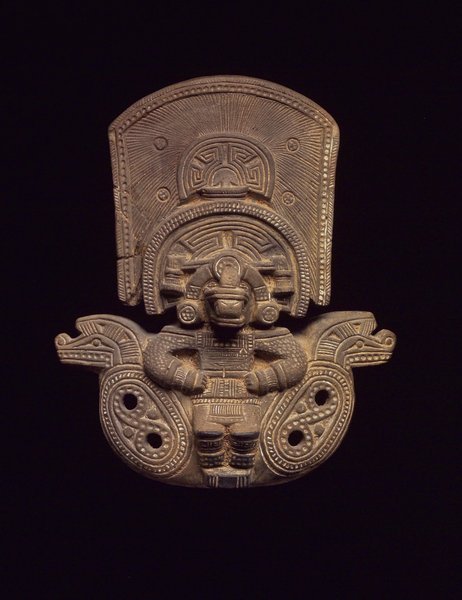Ocarina in the Form of a Seated Figure Item Number: 71.128 from the Brooklyn Museum



Description
Ocarina in the form of a seated figure of a man or bat deity wearing a fan headdress. The area where the figure is resting is bound by two serpents and wind instrument is decorated by incision marks that are filled with white paint. The front of the figure has four air vents; the back has three. Condition: generally good. There is a repair to proper left side of the crown: three areas have been broken off and repaired; also, each side of the upper corner has a small chip.
Credit Line
Gift of Mr. and Mrs. Tessim Zorach
Label
This ocarina, a flute-like instrument, depicts a shaman sitting on a double-headed crocodile bench and wearing elaborate garments, a large, feathered headdress, and a bat or crocodile mask. The ceremonial bench and both animals are associated with shamanic power. Crocodiles are powerful symbols that relate to fertility and the underworld because of their water- and land-based habitat. The musician would blow through a hole at the top of the headdress and place his fingers on the holes to control the tones. The Kogi people of Colombia still play ocarinas.
Esta ocarina, un instrumento parecido a una flauta, representa a un chamán sentado en una banca en forma de cocodrilo bicéfalo, vistiendo elaborados ropajes, tocado emplumado, y una máscara de murciélago o cocodrilo. La banca ceremonial y los dos animales están asociados al poder chamánico. Los cocodrilos son símbolos poderosos que se relacionan a la fertilidad y al inframundo por su hábitat tanto acuático como terrestre. El músico soplaba a través del agujero en la parte superior del tocado, y ponía los dedos en los agujeros para controlar los tonos. Los Kogi de Colombia aún tocan ocarinas.
Item History
- Made during 1200
What
Who
- Culture
- Tairona
Where
- Holding Institution
- Brooklyn Museum
When
- Creation Date
- during 1200
Other
- Location
- Arts of the Americas Galleries, 5th Floor
- Classification
- (not assigned)